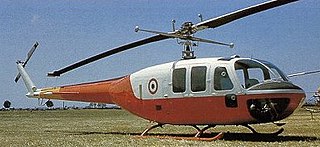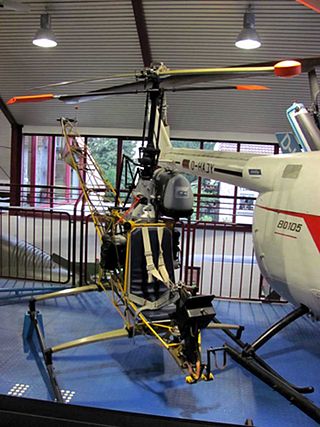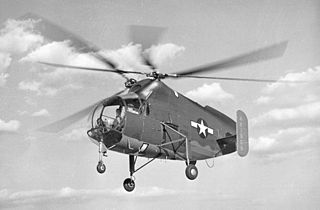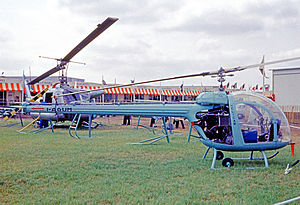
The Aerotécnica AC-12Pepo is a Spanish two-seat light helicopter manufactured in 1956 by Aerotécnica.

The Aerotécnica AC-14 was a Spanish five-seat light helicopter of the 1950s, designed by Jean Cantinieau, based on enlarging his Nord Norelfe design.

The Agusta A.115 was a prototype helicopter flown in 1961 in Italy. It was essentially a Bell 47J-3 with an unclad, tubular tail boom, and powered by a Turbomeca Astazou II turboshaft engine. No production ensued.

The Agusta A.101 was a large prototype transport helicopter developed in Italy during the 1960s. Despite prospective orders from the Italian armed forces, no buyers emerged and the project was abandoned in 1971.

The Agusta A.103 was an Italian prototype single-seat light helicopter flown in October 1959. The pilot was enclosed by a perspex bubble with the engine at the rear and the tail rotor carried on an enclosed boom.

The Agusta A.106 was a single-seat light helicopter designed to provide an anti-submarine warfare (ASW) platform for the Impavido-class destroyers of the Italian Navy. The aircraft was provided with a sophisticated electronics suite by Ferranti for autostabilisation and contact identification. Two torpedoes could be slung under the fuselage. The tail and two-bladed main rotor could be folded for shipboard stowage, and the skid undercarriage had fittings for flotation bags.

The Agusta AB.102 was an Italian helicopter produced in small numbers in the early 1960s. The aircraft was based on the mechanical components of a Bell 48 that Agusta incorporated into an all-new, streamlined fuselage. The first flight was on 3 February 1959 and the prototype was exhibited at that year's Paris Air Show in faux military colours. Only two production examples were built, operated by Elivie in a regular air service between Turin and Milan from 1961. However, the advent of turbine-powered helicopters in the 1960s soon rendered the AB.102 obsolete.

The Agusta AZ.8L, or Agusta-Zappata AZ.8L, was an Italian airliner prototype first flown on 9 June 1958. It was of conventional low-wing monoplane configuration with tricycle undercarriage and all-metal construction. Filippo Zappata's design grew out of a twin-engined transport designated AZ.1 that was never built.

The Bölkow Bo 103 was an ultralight experimental helicopter flown in West Germany in 1961. It was designed for reconnaissance and command-control purposes and constructed by Bölkow Entwicklungen KG as part of a research order by the German Federal Ministry of Defense.

The Doman LZ-5 was a utility helicopter developed in the United States in the early 1950s by Doman Helicopters Inc. of Danbury, Connecticut. Despite the procurement of international manufacturing agreements, no series production of the aircraft ever occurred, and only three prototypes were built. Two of these were purchased by the United States Army as the YH-31, but eventually becoming VH-31.

The Cicaré CK.1 was a light helicopter developed in Argentina in the 1970s. It was a small, single-rotor aircraft of pod-and-boom configuration with a fully enclosed bubble canopy that could seat three people side-by-side. Cicaré's previous helicopter designs had attracted the attention of the Argentine Air Force, which in 1974 contracted him to develop a light helicopter for training and also marketed for agricultural use. A prototype, registered LV-X62 flew in September 1976, and the Air Force placed an order for five pre-production machines. However, development was terminated at this point.

The Cierva CR Twin was a five-seat utility helicopter that first flew in the UK in 1969. It was a joint development between Cierva Autogiro Company and Rotorcraft now a subsidiary of Cierva, based on the dynamic systems of the latter company's Grasshopper design. A new, highly streamlined pod-and-boom fuselage was married to the Grasshopper's coaxial rotor system, and the new aircraft registered G-AWRP first flew on 18 August 1969.

The Gyrodyne RON Rotorcycle was a tiny, single-seat helicopter designed under contract for the United States Navy. in the mid-1950s. It later was redesigned for a U.S. Marine Corps requirement for a small personal helicopter that would fulfill a number of roles, including observation, liaison, small unit tactical maneuvers, and which could be dropped to downed airmen behind enemy lines to facilitate their escape.

The HTM Skytrac was a light utility helicopter developed in Germany in the 1960s and 70s. A later four-seat version was known as the Skyrider. Despite achieving certification from the German aviation authorities and firm orders from customers, the Skytrac was never produced in series.

The Kawasaki KH-4 was a light utility helicopter produced in Japan in the 1960s as a development of the Bell 47 that Kawasaki had been building under licence since 1952. The most visible difference between the KH-4 and its forerunner was its new and enlarged cabin. This was fully enclosed and provided seating for three passengers side-by-side on a bench seat behind the pilot's seat. The helicopter was provided with a new control system, revised instrumentation, and larger fuel tank.

The Kellett XR-8 was a helicopter built in the United States during World War II. It was a two-seat machine intended to demonstrate the feasibility of a twin-rotor system and, while it accomplished this, it also demonstrated a number of problems that prevented further development of this particular design.

The Kellett XR-10 was a military transport helicopter developed in the United States in the 1940s that only flew in prototype form. It was designed in response to a USAAF Technical Instruction issued for the development of a helicopter to transport passengers, cargo, or wounded personnel within an enclosed fuselage. Kellett's proposal followed the general layout that the company was developing in the XR-8, with twin intermeshing rotors, and was accepted by the Air Force on 16 October over proposals by Sikorsky, Bell, and Platt-LePage.
The Meridionali/Agusta EMA 124 was a light utility helicopter flown in prototype form in Italy in 1970. The design was undertaken by Agusta for production in a joint venture with Elicotteri Meridionali, based on the Bell 47 that Agusta was building under licence at the time.
The Omega BS-12 was a utility helicopter with high ground clearance designed to carry loads behind the cabin at, or near, the center of gravity.
The VTOL Aircraft Phillicopter is a 1970s Australian light utility helicopter designed and built by VTOL Aircraft of Newcastle West, New South Wales.

















